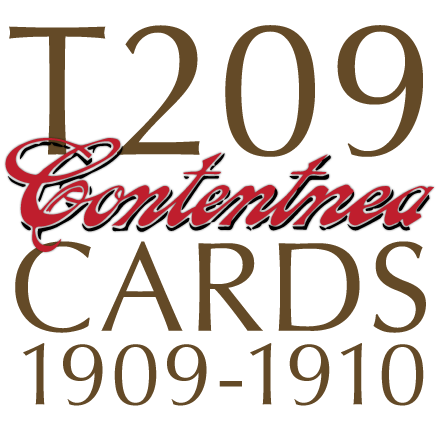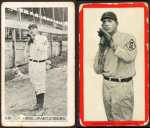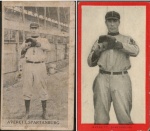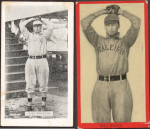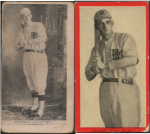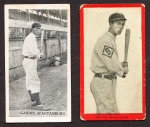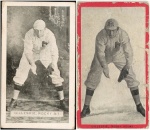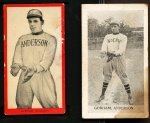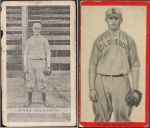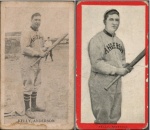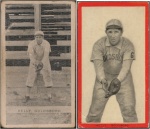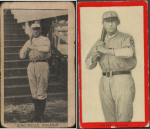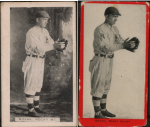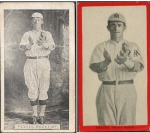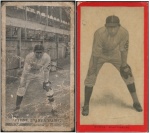T209-II player photos represent some of the most fascinating images in early baseball cards. Ten of the eighteen teams represented in the set feature players posed in actual ballparks, while the other eight teams reproduce studio portraits and poses. The stadium poses are compelling because they reveal the uniforms and equipment worn by minor league players, and portray what Class D minor league stadiums looked like in 1910. The depicted players represent cultural history at a specific time in American sports.
Independent photographers, who operated throughout the southern leagues and sold images to cigarette manufacturers, probably took many of the stadium photos. This assessment is supported by the appearance of many of the same player images that appear on cards in the T209 set and on T210 Old Mill cigarette cards. There were also local photographers, like Clement Photography in Goldsboro, NC, that took team and player photographs for the hometown Goldsboro Giants. Drawing from this pool of photographers, twenty-five T210-7 cards (Eastern Carolina League), thirteen T210-5 cards (Carolina Association), and five T210-2 cards (Virginia League) share player photos with T209-II.
The examples below demonstrate that while the poses are the same, the final image is usually altered in T210 cards. Instead of reproducing original photographs like T209-II, T210 uses lithographic player depictions similar to T206. Another major difference is that T210 versions eliminate background subject matter, like stadiums, that T209 photographs reveal, making T210 images somewhat generic and uninteresting. Because T210 cards were produced lithographically, occasionally team logos were superimposed on a player’s shirt, hat or sleeve to help the viewer identify the player’s affiliation, even though team logos did not exist in the original photograph. That kind of identification seemed unnecessary in T209 since contemporary viewers probably recognized the player on his card.
Most T210 cards present player images that have been reduced or cropped from corresponding T209 cards. This is evident in the cards of Abercrombie (stadium pose) and Bonner (studio pose), both of which are abridged from the T209 version. Interestingly, only eight studio photographs are represented among the forty-three shared images.
Comparing player images from each set also reveals that photographers routinely took multiple exposures of each player, as the two Galvin cards demonstrate. At first glance they appear to be the same pose, but upon closer inspection the T209 Galvin version seems to have been taken a few frames later than its T210 counterpart. Variations suggest that cigarette manufacturers could choose from several poses before deciding on the image that would be used for a card.
Like Red Sun’s T211, and Old Mill’s T210-8, T209-II and T210 cards occasionally shared player images. While this may not be interesting from a purely artistic perspective, it does reveal another small piece of information about the production of Southern minor league cards in the early years of baseball’s popularity.
- Abercrombie / T210-5
- Averett / T210-5
- Baker / T210-2
- Beatty / T210-7
- Biel / T210-7
- Bonner / T210-7
- Brown / T210-2
- Corbett / T210-5
- Creagan / T210-7
- Dailey / T210-7
- Evans / T210-7
- Fairbanks / T210-5
- Farmer / T210-5
- Forgue / T210-7
- Fulton / T210-7
- Galvin / T210-7
- Gardin / T210-5
- Gastmeyer / T210-7
- Gates / T210-7
- Gillespie / T210-7
- Gorham / T210-5
- Gunderson / T210-7
- Hale / T210-2
- Harrington / T210-5
- Harris / T210-5
- Hartley / T210-5
- Irvine / T210-2
- Irving / T210-7
- Kelly-Anderson / T210-5
- Kelly / T210-7
- King Kelly / T210-7
- Landgraff / T210-2
- Malcom / T210-7
- A. McCarthy / T210-5
- Novak (Noval) / T210-7
- Phealean (Phelan) / T210-7
- Reeves / T210-7
- Sharp / T210-7
- Sherrill / T210-7
- Simmons / T210-7
- Steinbach / T210-7
- Stoehr / T210-7
- Wynne / T210-5
